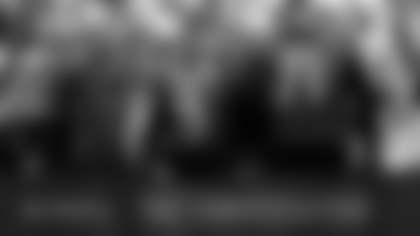2-2-01, 8:45 p.m.
NEW ORLEANS _ Forget the side shows and the freak shows and the just plain shows.
Forget all that. The biggest Bourbon Street double take this week besides the bar-hopping Dennis Rodman was the throng that engulfed Rams tackle Rod Jones early Thursday night.
Strange but friendly women gleefully hugged him for photos. Men asked him to sign big plastic cups that hold drinks strong enough to fuel three earth orbits. He looked into the crowd and smiled when someone yelled, "Look, its Brock Gutietrrez," the name of the Bengals backup center and Jones' friend.
Four months ago, of course, the idea of Jones being the toast of the Super Bowl would be as ludicrous as the Patriots joining him and George Bush being mentioned in the same breath as FDR.
But things change and here we are on Bourbon Street and don't let Rod Jones get away from you because he is the key matchup in Super Bowl XXXVI. And not just because he's a former Bengal.
Everyone is comparing this Super Bowl to the one 11 years ago in which Belichick's Giants defense stunned the heavily-favored and high-octane Bills' offense, 20-19, in Super Bowl XXV.
But the only similarity is that America is at war and the game is being played under intense security inside a bunker. There is no Whitney Houston. This is Paul McCartney's Super Bowl. But (Sgt.) Pepper Johnson remembers.
"We pretty much tried to stop (Bills receiver) Andre Reed and his various routes over the middle," said Johnson a Giants linebacker that day who is now the Patriots inside linebackers coach. "This Rams' offense, they have three Andre Reeds over there."
And no one on this universe has ever had a guy like Rams running back Marshall Faulk, who Johnson says, "could be their best receiver. He just doesn't run out for dump passes. He gets position on his routes."
Bills running back Thurman Thomas was good, Johnson said, but he never lined up as an outside receiver like Faulk does : "I'm not saying Thurman couldn't have done what Marshall does, but he was just running running back routes. If Marshall ever decided he didn't want to be a running back and just be a receiver, he'd catch 100 balls for 1,400 or 1,500 yards."
But as it was, Thomas did hurt the Giants. He rushed for 135 yards and caught 55 more. The problem was, the Giants' offense beat him because it had the ball for all but 19:27 of the game as the Bills went a point a minute.
Which gets us back to the 340-pound Jones and his match up against the Pats' 275-pound defensive ends. In that Super Bowl 11 years ago, Johnson remembers the Giants so worried about the pass that at times they played only two defensive linemen.
If the Pats plan to battle the Rams' attack with multi defensive backs, the Rams' could really foul up the Pats by shelving "The Greatest Show on Turf," and pulling out "The Best Little Running Game in the NFC."
Even when Jones struggled terribly last season with the Bengals against pass rushers at left tackle, he could always run block and he's still doing it at right tackle for the Rams.
In their two playoff games in which he has been at either tackle spot, Faulk is averaging 5.1 yards per his 47 carries. In Jones' one regular-season start
against the Jets, the Rams averaged 6.8 yards per their 34 pops.
You know Belichick is going to test Jones' prowess on the pass rush. He has to after Jones struggled against New England last year while playing for the Bengals.
Belichick will no doubt send not only the kitchen sink at him, but also the dishwasher and hair dryer in the form of various stunts and blitzes. Jones is already anticipating the dreaded pick play.
Belichick unleashed his Pandora's Box of Xs and Os back on Nov. 18 in the Sunday night game in Foxboro in which the Pats jumped to a 10-7 lead 54 seconds into the second quarter on scores set up by two Kurt Warner interceptions. The Pats changed from three-man fronts to four-man fronts and back. Sometimes they dropped eight men into pass coverage . Sometimes they blitzed the corners.
But the Rams settled down to fend off the Pats, 24-17. And they did it by draining the game's last seven minutes with Faulk pounding out 53 yards on the final drive.
Belichick appreciates the similarities of the Tampa upset in '91. The Bills had then what the Rams have now in a Hall of Fame quarterback, versatile running back, and a veteran offensive line. But that's where it ends.
"That '90 Buffalo team was a team that usually ran only one formation, sometimes two," Belichick said. "No huddle, their pace was very quick. It was a tempo offense. St. Louis is the antithesis of that. They almost never give you one formation. It's hard to find the same formation within the entire game, let alone in any type of situation which repeats.
"They have so much movement and formationing and shifting and utilization of multiple personnel groups as opposed to Buffalo, which usually left 11 players on the field," Belichick said. "St. Louis comes at you from a lot of different directions. . .So by the end of the day, I'd say, the chances of one formation in the same personnel group repeating within the game would be about one in 50."
Pats defensive coordinator Romeo Crennel, who coached the Giants defensive line that day, says it's imperative New England not give up the easy big play. Which is why the shifting worries him.
"If you're really not on top of it, you end up setting a guy free," Crennel said. "Because they line up (Faulk) as the end man at the X position, and then they shift back into the backfield and then shift him out of the backfield, if you don't have a good plan to handle those shifts and motions, someone is going to get turned free and it will be easy.
"We don't want them to get an easy one," Crennel said. "They make it look easy. The thing you can't do is you can't let a guy run free. . .They're going to hurt you anyway. If you make them work for it and stay close, then you're going to have a chance."
Which is what the Giants did 11 years ago. Johnson says New York concentrated on Buffalo's skill players.
"We stopped their passing game," Johnson said. "Belichick told us we were going to give up a few yards to Thurman Thomas because of the personnel we had on the field. We were going to give up some running yardage to those guys running the ball, but we weren't going to allow them to make passing plays. We just wanted to limit their game. Just get those guys running the ball, then our athletic ability and our will would try to overcome that."
But who wants Faulk to run the ball? The idea for the defense is usually to make an offense one dimensional. But Pats cornerback Terrell Buckley, who picked off Warner back in November and ran it back for a touchdown, calls it "a dilemma."
"Usually you want teams to pass, but don't know if you want this team to pass," Buckley said. "Probably want to let them run. It's almost like rolling the dice."
But Buckley has already seen Faulk kill the clock with the run.
"It's a bad situation for us," Buckley said.
Belichick: "If we don't play any better than we did on November (18), we'll get the same result. Maybe worse."
The problem is, the Pats must have played pretty well because they hung close. It may not matter how well they play. The St. Louis defense is too good for a second-year quarterback to keep the ball 40 minutes.
Call it Rams 28, Patriots 14 behind Faulk's 130-plus rushing yards as Mike Martz realizes you have to take the shoot out of run to win Super Bowls.





